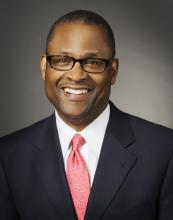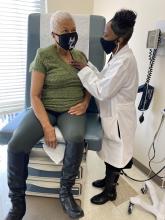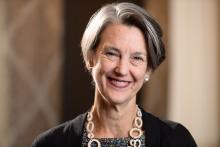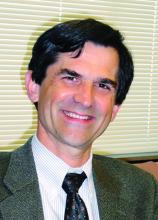User login
––
The reasons for this less frequent contact and the ramifications for patients and doctors practicing primary care are unclear, according to various experts. But some offered possible explanations for the changes, with patients’ increased participation in high deductible plans and shortages in primary care physicians (PCPs) being among the most often cited.
The findings, which were published online Jan. 11 in Annals of Family Medicine, were derived from researchers using a repeated cross-sectional study of the 2002-2017 Medical Expenditure Panel Survey to characterize trends in primary care use. This survey, which collected information about medical care utilization from individuals and families, included 243,919 participants who were interviewed five times over 2 years. The authors defined primary care physician contact as “in-person visit or contact with a primary care physician (primarily telephone calls) with a reported specialty of family medicine, general internal medicine, geriatrics, general pediatrics, or general practice physician.” According to the paper, “the proportion of individuals with any primary care physician contact was determined for both the population and by age group using logistic regression models,” and negative binomial regression models were used to determine the number of contacts among people with visits during 2-year periods.
The study authors, Michael E. Johansen, MD, MS, and Joshua D. Niforatos, MD, MTS, said their study suggests that previously reported decreases in primary care contact was caused by fewer contacts per patient “as opposed to an absolute decrease in the number of patients in contact with primary care.”
Harold B. Betton, MD, PhD, who practices family medicine in Little Rock, Ark., questioned this claim.
“In my reading, the authors concluded that people are seeing their primary care physicians fewer times than in the past, which suggests something is happening,” Dr. Betton said in an interview. “The fact that fewer visits are occurring may be due to multiple things, i.e., urgent care visits, visits to physician extenders – physician assistants and advanced practice nurses – or emergency room visits.”
"The paper draws observational conclusions and I fail to see the merit in the observation without knowing what the respondents were asked and not asked," he added.
Other primary care physicians suggested patients’ participation in alternative pay models and high-deductible plans have played a factor in the declines.
“Most of us have gone from fee-for-service, volume-based care to more value-based care,” Ada D. Stewart, MD, president of the American Academy of Family Physicians, said in an interview. The data reflect that trend, “whereas we were rewarded more for the number of people we were seeing, now we are trying to get towards more of the value that we provide,” suggested Dr. Stewart, who also practices family medicine with Cooperative Health in Columbia, S.C.
“Given the rise of high-deductible plans and copays, it is not surprising that younger patients, a generally healthier population, might well decrease their visits to a primary care physician. I would suspect that data for patients over 50 might well be different,” William E. Golden, MD, who is medical director at the Arkansas Department of Health & Human Services, noted in an interview.
Eileen Barrett, MD, MPH, also cited greater participation in high-deductible plans as a possible factor that could be leading some patients to forgo visits, as well as increased financial insecurity, rendering it expensive to have the visit and also to take time from work for the visit.
“I would wonder if some of this is also due to how overloaded most primary care offices are so that instead of stopping accepting new patients or shedding patients, it is just harder for existing patients to be seen,” said Dr. Barrett, who is a general internist and associate professor in the division of hospital medicine, department of internal medicine, at the University of New Mexico, Albuquerque. “Some of this could be from administrative burden – 2 hours per hour of clinic – and consequently reducing clinical time,” continued Dr. Barrett, who also serves on the editorial advisory board of Internal Medicine News, which is affiliated with Family Practice News.
Other experts pointed to data showing an insufficient supply of PCPs as a potential explanation for the new study’s findings. The Health Resources and Services Organization, for example, reported that 83 million Americans live in primary care “health professional shortage areas,” as of Jan. 24, 2021, on their website.
New data
“The rate of any contact with a [PCP] for patients in the population over multiple 2-year periods decreased by 2.5% over the study period (adjusted odds ratio, 0.99 per panel; 95% [confidence interval], 0.98-0.99; P < .001),” wrote Dr. Johansen and Dr. Niforatos. The rate of contact for patients aged 18-39 years (aOR, 0.99 per panel; 95% CI, 0.98-0.99; P < .001) and patients aged 40-64 years (aOR, 0.99 per panel; 95% CI, 0.99-1.00; P = .002), specifically, also fell. These decreased contact rates correspond “to a predicted cumulative 5% absolute decrease for the younger group and a 2% absolute decrease for the older group,” the authors added.
“The number of contacts with a [PCP] decreased among individuals with any contact by 0.5 contacts over 2 years (P < .001). A decrease in the number of [PCP] contacts was observed across all age groups (P < .001 for all), with the largest absolute decrease among individuals with higher contact rates (aged less than 4 years and aged greater than 64 years),” according to the paper.
Outlook for PCPs
Physicians questioned about how concerning these data are for the future of PCPs and their ability to keep their practices running were hesitant to speculate, because of uncertainty about the causes of the study findings.
“A quote from the paper indicates that the respondents were interviewed five times over 2 years; however, without a copy of the questionnaire it is impossible to know what they were asked and not asked,” said Dr. Betton, who also serves on the editorial advisory board of Family Practice News and runs his own private practice. “In addition, it is impossible for the reader to know whether they understood what a primary care physician was to do.
“To draw a conclusion that PCP visits are falling off per patient per provider is only helpful if patients are opting out of the primary care model of practice and opting in for point-of-care [urgent] care,” Dr. Betton added.
Internist Alan Nelson, MD, said he was also undecided about whether the findings of the study are good or bad news for the physician specialty of primary care.
“Similar findings have been reported by the Medicare Payment Advisory Commission. They certainly merit further investigation,” noted Dr. Nelson, who is a member of the editorial advisory board of Internal Medicine News. “Is it because primary care physicians are too busy to see additional patients? Is it because nonphysician practitioners seem to be more caring? Should residency training be modified, and if so, how? In the meantime, I would not be surprised if the trend continues, at least in the short term.”
Ann Greiner, president and CEO of the Primary Care Collaborative, a nonprofit organization that advocates to strengthen primary care and make it more responsive to patient needs and preferences, on the other hand, reacted with a concerned outlook for primary care.
This study and others show that “the U.S. health care system is moving away from a primary care orientation, and that is concerning,” Ms. Greiner said in an interview. “Health systems that are more oriented toward primary care have better population health outcomes, do better on measures of equity across different population groups, and are less costly.”
Authors’ take
“Future research is needed to determine whether fewer contacts per patient resulted in clinically meaningful differences in outcomes across disease processes,” wrote Dr. Johansen, who is a family medicine doctor affiliated with OhioHealth Family Medicine Grant in Columbus and with the Heritage College of Osteopathic Medicine at Ohio University, Dublin, and Dr. Niforatos, who is affiliated with the department of emergency medicine at Johns Hopkins University, Baltimore.
The study’s limitations included reliance on self-reported categorization of PCP versus specialty care physician contact, insufficient accounting for nurse practitioner and physician assistant contact, and improved contact reporting having started in 2013, they said.
How to grow patient contact
For those PCPs looking to grow their visits and patient contact, Dr. Golden suggested they strengthen their medical home model in their practice.
“Medical home models help and transform practice operations. The Arkansas model is a multipayer model – private, Medicaid and CPC+ (Medicare),” said Dr. Golden, who also serves on the editorial advisory board of Internal Medicine News. It includes community-based doctors, not Federally Qualified Health Centers, and “requires 24/7 live voice access that promotes regular contact with patients and can reduce dependency on ER and urgent care center visits.”
“Greater use of patient portals and email communications facilitate access and patient engagement with their PCP,” Dr. Golden explained.
“Over the last 6 years, the Arkansas [patient-centered medical home] initiatives have altered culture and made our practice sites stronger to withstand COVID and other challenges. As our sites became more patient centered and incorporated behavioral health options, patients perceived greater value in the functionality of primary care” he said.
Dr. Barrett proposed PCPs participate in team-based care “for professional sustainability and also for patients to continue to experience high-quality, person-centered care.” She added that “telemedicine can also help practices maintain and increase patients, as it can lessen burden on patients and clinicians – if it is done right.”
“More flexible clinic hours is also key – after usual business hours and on weekends – but I would recommend in lieu of usual weekday hours and for those who can make it work with their family and other duties,” Dr. Barrett said. “Evening or Saturday morning clinic isn’t an option for everyone, but it is an option for many some of the time, and it would be great for access to care if it were available in more locations.”
Pandemic effect
The data examined by Dr. Johansen and Dr. Niforatos predates the pandemic, but PCPs interviewed by this news organization have seen declining patient contact occur in 2020 as well.
In fact, a survey of 1,485 mostly physician primary care practitioners that began after the pandemic onset found that 43% of participants have fewer in-person visits, motivated largely by patient preferences (66%) and safety concerns (74%). This ongoing survey, which was conducted by the Larry Green Center in partnership with the Primary Care Collaborative, also indicated that, while 25% of participants saw a total increase in patient volume, more than half of primary care practitioners reported that chronic and wellness visits are down, 53% and 55%, respectively.
“Sometimes we have to go looking for our patients when we have not seen them in a while,” Dr. Stewart noted. “We saw that with COVID because people were fearful of coming into our offices, and we had to have some outreach.”
The study authors had no conflicts of interest. Dr. Barrett, Dr. Betton, Dr. Golden, Dr. Nelson, and Dr. Stewart had no relevant disclosures.
Jake Remaly contributed to this article.
––
The reasons for this less frequent contact and the ramifications for patients and doctors practicing primary care are unclear, according to various experts. But some offered possible explanations for the changes, with patients’ increased participation in high deductible plans and shortages in primary care physicians (PCPs) being among the most often cited.
The findings, which were published online Jan. 11 in Annals of Family Medicine, were derived from researchers using a repeated cross-sectional study of the 2002-2017 Medical Expenditure Panel Survey to characterize trends in primary care use. This survey, which collected information about medical care utilization from individuals and families, included 243,919 participants who were interviewed five times over 2 years. The authors defined primary care physician contact as “in-person visit or contact with a primary care physician (primarily telephone calls) with a reported specialty of family medicine, general internal medicine, geriatrics, general pediatrics, or general practice physician.” According to the paper, “the proportion of individuals with any primary care physician contact was determined for both the population and by age group using logistic regression models,” and negative binomial regression models were used to determine the number of contacts among people with visits during 2-year periods.
The study authors, Michael E. Johansen, MD, MS, and Joshua D. Niforatos, MD, MTS, said their study suggests that previously reported decreases in primary care contact was caused by fewer contacts per patient “as opposed to an absolute decrease in the number of patients in contact with primary care.”
Harold B. Betton, MD, PhD, who practices family medicine in Little Rock, Ark., questioned this claim.
“In my reading, the authors concluded that people are seeing their primary care physicians fewer times than in the past, which suggests something is happening,” Dr. Betton said in an interview. “The fact that fewer visits are occurring may be due to multiple things, i.e., urgent care visits, visits to physician extenders – physician assistants and advanced practice nurses – or emergency room visits.”
"The paper draws observational conclusions and I fail to see the merit in the observation without knowing what the respondents were asked and not asked," he added.
Other primary care physicians suggested patients’ participation in alternative pay models and high-deductible plans have played a factor in the declines.
“Most of us have gone from fee-for-service, volume-based care to more value-based care,” Ada D. Stewart, MD, president of the American Academy of Family Physicians, said in an interview. The data reflect that trend, “whereas we were rewarded more for the number of people we were seeing, now we are trying to get towards more of the value that we provide,” suggested Dr. Stewart, who also practices family medicine with Cooperative Health in Columbia, S.C.
“Given the rise of high-deductible plans and copays, it is not surprising that younger patients, a generally healthier population, might well decrease their visits to a primary care physician. I would suspect that data for patients over 50 might well be different,” William E. Golden, MD, who is medical director at the Arkansas Department of Health & Human Services, noted in an interview.
Eileen Barrett, MD, MPH, also cited greater participation in high-deductible plans as a possible factor that could be leading some patients to forgo visits, as well as increased financial insecurity, rendering it expensive to have the visit and also to take time from work for the visit.
“I would wonder if some of this is also due to how overloaded most primary care offices are so that instead of stopping accepting new patients or shedding patients, it is just harder for existing patients to be seen,” said Dr. Barrett, who is a general internist and associate professor in the division of hospital medicine, department of internal medicine, at the University of New Mexico, Albuquerque. “Some of this could be from administrative burden – 2 hours per hour of clinic – and consequently reducing clinical time,” continued Dr. Barrett, who also serves on the editorial advisory board of Internal Medicine News, which is affiliated with Family Practice News.
Other experts pointed to data showing an insufficient supply of PCPs as a potential explanation for the new study’s findings. The Health Resources and Services Organization, for example, reported that 83 million Americans live in primary care “health professional shortage areas,” as of Jan. 24, 2021, on their website.
New data
“The rate of any contact with a [PCP] for patients in the population over multiple 2-year periods decreased by 2.5% over the study period (adjusted odds ratio, 0.99 per panel; 95% [confidence interval], 0.98-0.99; P < .001),” wrote Dr. Johansen and Dr. Niforatos. The rate of contact for patients aged 18-39 years (aOR, 0.99 per panel; 95% CI, 0.98-0.99; P < .001) and patients aged 40-64 years (aOR, 0.99 per panel; 95% CI, 0.99-1.00; P = .002), specifically, also fell. These decreased contact rates correspond “to a predicted cumulative 5% absolute decrease for the younger group and a 2% absolute decrease for the older group,” the authors added.
“The number of contacts with a [PCP] decreased among individuals with any contact by 0.5 contacts over 2 years (P < .001). A decrease in the number of [PCP] contacts was observed across all age groups (P < .001 for all), with the largest absolute decrease among individuals with higher contact rates (aged less than 4 years and aged greater than 64 years),” according to the paper.
Outlook for PCPs
Physicians questioned about how concerning these data are for the future of PCPs and their ability to keep their practices running were hesitant to speculate, because of uncertainty about the causes of the study findings.
“A quote from the paper indicates that the respondents were interviewed five times over 2 years; however, without a copy of the questionnaire it is impossible to know what they were asked and not asked,” said Dr. Betton, who also serves on the editorial advisory board of Family Practice News and runs his own private practice. “In addition, it is impossible for the reader to know whether they understood what a primary care physician was to do.
“To draw a conclusion that PCP visits are falling off per patient per provider is only helpful if patients are opting out of the primary care model of practice and opting in for point-of-care [urgent] care,” Dr. Betton added.
Internist Alan Nelson, MD, said he was also undecided about whether the findings of the study are good or bad news for the physician specialty of primary care.
“Similar findings have been reported by the Medicare Payment Advisory Commission. They certainly merit further investigation,” noted Dr. Nelson, who is a member of the editorial advisory board of Internal Medicine News. “Is it because primary care physicians are too busy to see additional patients? Is it because nonphysician practitioners seem to be more caring? Should residency training be modified, and if so, how? In the meantime, I would not be surprised if the trend continues, at least in the short term.”
Ann Greiner, president and CEO of the Primary Care Collaborative, a nonprofit organization that advocates to strengthen primary care and make it more responsive to patient needs and preferences, on the other hand, reacted with a concerned outlook for primary care.
This study and others show that “the U.S. health care system is moving away from a primary care orientation, and that is concerning,” Ms. Greiner said in an interview. “Health systems that are more oriented toward primary care have better population health outcomes, do better on measures of equity across different population groups, and are less costly.”
Authors’ take
“Future research is needed to determine whether fewer contacts per patient resulted in clinically meaningful differences in outcomes across disease processes,” wrote Dr. Johansen, who is a family medicine doctor affiliated with OhioHealth Family Medicine Grant in Columbus and with the Heritage College of Osteopathic Medicine at Ohio University, Dublin, and Dr. Niforatos, who is affiliated with the department of emergency medicine at Johns Hopkins University, Baltimore.
The study’s limitations included reliance on self-reported categorization of PCP versus specialty care physician contact, insufficient accounting for nurse practitioner and physician assistant contact, and improved contact reporting having started in 2013, they said.
How to grow patient contact
For those PCPs looking to grow their visits and patient contact, Dr. Golden suggested they strengthen their medical home model in their practice.
“Medical home models help and transform practice operations. The Arkansas model is a multipayer model – private, Medicaid and CPC+ (Medicare),” said Dr. Golden, who also serves on the editorial advisory board of Internal Medicine News. It includes community-based doctors, not Federally Qualified Health Centers, and “requires 24/7 live voice access that promotes regular contact with patients and can reduce dependency on ER and urgent care center visits.”
“Greater use of patient portals and email communications facilitate access and patient engagement with their PCP,” Dr. Golden explained.
“Over the last 6 years, the Arkansas [patient-centered medical home] initiatives have altered culture and made our practice sites stronger to withstand COVID and other challenges. As our sites became more patient centered and incorporated behavioral health options, patients perceived greater value in the functionality of primary care” he said.
Dr. Barrett proposed PCPs participate in team-based care “for professional sustainability and also for patients to continue to experience high-quality, person-centered care.” She added that “telemedicine can also help practices maintain and increase patients, as it can lessen burden on patients and clinicians – if it is done right.”
“More flexible clinic hours is also key – after usual business hours and on weekends – but I would recommend in lieu of usual weekday hours and for those who can make it work with their family and other duties,” Dr. Barrett said. “Evening or Saturday morning clinic isn’t an option for everyone, but it is an option for many some of the time, and it would be great for access to care if it were available in more locations.”
Pandemic effect
The data examined by Dr. Johansen and Dr. Niforatos predates the pandemic, but PCPs interviewed by this news organization have seen declining patient contact occur in 2020 as well.
In fact, a survey of 1,485 mostly physician primary care practitioners that began after the pandemic onset found that 43% of participants have fewer in-person visits, motivated largely by patient preferences (66%) and safety concerns (74%). This ongoing survey, which was conducted by the Larry Green Center in partnership with the Primary Care Collaborative, also indicated that, while 25% of participants saw a total increase in patient volume, more than half of primary care practitioners reported that chronic and wellness visits are down, 53% and 55%, respectively.
“Sometimes we have to go looking for our patients when we have not seen them in a while,” Dr. Stewart noted. “We saw that with COVID because people were fearful of coming into our offices, and we had to have some outreach.”
The study authors had no conflicts of interest. Dr. Barrett, Dr. Betton, Dr. Golden, Dr. Nelson, and Dr. Stewart had no relevant disclosures.
Jake Remaly contributed to this article.
––
The reasons for this less frequent contact and the ramifications for patients and doctors practicing primary care are unclear, according to various experts. But some offered possible explanations for the changes, with patients’ increased participation in high deductible plans and shortages in primary care physicians (PCPs) being among the most often cited.
The findings, which were published online Jan. 11 in Annals of Family Medicine, were derived from researchers using a repeated cross-sectional study of the 2002-2017 Medical Expenditure Panel Survey to characterize trends in primary care use. This survey, which collected information about medical care utilization from individuals and families, included 243,919 participants who were interviewed five times over 2 years. The authors defined primary care physician contact as “in-person visit or contact with a primary care physician (primarily telephone calls) with a reported specialty of family medicine, general internal medicine, geriatrics, general pediatrics, or general practice physician.” According to the paper, “the proportion of individuals with any primary care physician contact was determined for both the population and by age group using logistic regression models,” and negative binomial regression models were used to determine the number of contacts among people with visits during 2-year periods.
The study authors, Michael E. Johansen, MD, MS, and Joshua D. Niforatos, MD, MTS, said their study suggests that previously reported decreases in primary care contact was caused by fewer contacts per patient “as opposed to an absolute decrease in the number of patients in contact with primary care.”
Harold B. Betton, MD, PhD, who practices family medicine in Little Rock, Ark., questioned this claim.
“In my reading, the authors concluded that people are seeing their primary care physicians fewer times than in the past, which suggests something is happening,” Dr. Betton said in an interview. “The fact that fewer visits are occurring may be due to multiple things, i.e., urgent care visits, visits to physician extenders – physician assistants and advanced practice nurses – or emergency room visits.”
"The paper draws observational conclusions and I fail to see the merit in the observation without knowing what the respondents were asked and not asked," he added.
Other primary care physicians suggested patients’ participation in alternative pay models and high-deductible plans have played a factor in the declines.
“Most of us have gone from fee-for-service, volume-based care to more value-based care,” Ada D. Stewart, MD, president of the American Academy of Family Physicians, said in an interview. The data reflect that trend, “whereas we were rewarded more for the number of people we were seeing, now we are trying to get towards more of the value that we provide,” suggested Dr. Stewart, who also practices family medicine with Cooperative Health in Columbia, S.C.
“Given the rise of high-deductible plans and copays, it is not surprising that younger patients, a generally healthier population, might well decrease their visits to a primary care physician. I would suspect that data for patients over 50 might well be different,” William E. Golden, MD, who is medical director at the Arkansas Department of Health & Human Services, noted in an interview.
Eileen Barrett, MD, MPH, also cited greater participation in high-deductible plans as a possible factor that could be leading some patients to forgo visits, as well as increased financial insecurity, rendering it expensive to have the visit and also to take time from work for the visit.
“I would wonder if some of this is also due to how overloaded most primary care offices are so that instead of stopping accepting new patients or shedding patients, it is just harder for existing patients to be seen,” said Dr. Barrett, who is a general internist and associate professor in the division of hospital medicine, department of internal medicine, at the University of New Mexico, Albuquerque. “Some of this could be from administrative burden – 2 hours per hour of clinic – and consequently reducing clinical time,” continued Dr. Barrett, who also serves on the editorial advisory board of Internal Medicine News, which is affiliated with Family Practice News.
Other experts pointed to data showing an insufficient supply of PCPs as a potential explanation for the new study’s findings. The Health Resources and Services Organization, for example, reported that 83 million Americans live in primary care “health professional shortage areas,” as of Jan. 24, 2021, on their website.
New data
“The rate of any contact with a [PCP] for patients in the population over multiple 2-year periods decreased by 2.5% over the study period (adjusted odds ratio, 0.99 per panel; 95% [confidence interval], 0.98-0.99; P < .001),” wrote Dr. Johansen and Dr. Niforatos. The rate of contact for patients aged 18-39 years (aOR, 0.99 per panel; 95% CI, 0.98-0.99; P < .001) and patients aged 40-64 years (aOR, 0.99 per panel; 95% CI, 0.99-1.00; P = .002), specifically, also fell. These decreased contact rates correspond “to a predicted cumulative 5% absolute decrease for the younger group and a 2% absolute decrease for the older group,” the authors added.
“The number of contacts with a [PCP] decreased among individuals with any contact by 0.5 contacts over 2 years (P < .001). A decrease in the number of [PCP] contacts was observed across all age groups (P < .001 for all), with the largest absolute decrease among individuals with higher contact rates (aged less than 4 years and aged greater than 64 years),” according to the paper.
Outlook for PCPs
Physicians questioned about how concerning these data are for the future of PCPs and their ability to keep their practices running were hesitant to speculate, because of uncertainty about the causes of the study findings.
“A quote from the paper indicates that the respondents were interviewed five times over 2 years; however, without a copy of the questionnaire it is impossible to know what they were asked and not asked,” said Dr. Betton, who also serves on the editorial advisory board of Family Practice News and runs his own private practice. “In addition, it is impossible for the reader to know whether they understood what a primary care physician was to do.
“To draw a conclusion that PCP visits are falling off per patient per provider is only helpful if patients are opting out of the primary care model of practice and opting in for point-of-care [urgent] care,” Dr. Betton added.
Internist Alan Nelson, MD, said he was also undecided about whether the findings of the study are good or bad news for the physician specialty of primary care.
“Similar findings have been reported by the Medicare Payment Advisory Commission. They certainly merit further investigation,” noted Dr. Nelson, who is a member of the editorial advisory board of Internal Medicine News. “Is it because primary care physicians are too busy to see additional patients? Is it because nonphysician practitioners seem to be more caring? Should residency training be modified, and if so, how? In the meantime, I would not be surprised if the trend continues, at least in the short term.”
Ann Greiner, president and CEO of the Primary Care Collaborative, a nonprofit organization that advocates to strengthen primary care and make it more responsive to patient needs and preferences, on the other hand, reacted with a concerned outlook for primary care.
This study and others show that “the U.S. health care system is moving away from a primary care orientation, and that is concerning,” Ms. Greiner said in an interview. “Health systems that are more oriented toward primary care have better population health outcomes, do better on measures of equity across different population groups, and are less costly.”
Authors’ take
“Future research is needed to determine whether fewer contacts per patient resulted in clinically meaningful differences in outcomes across disease processes,” wrote Dr. Johansen, who is a family medicine doctor affiliated with OhioHealth Family Medicine Grant in Columbus and with the Heritage College of Osteopathic Medicine at Ohio University, Dublin, and Dr. Niforatos, who is affiliated with the department of emergency medicine at Johns Hopkins University, Baltimore.
The study’s limitations included reliance on self-reported categorization of PCP versus specialty care physician contact, insufficient accounting for nurse practitioner and physician assistant contact, and improved contact reporting having started in 2013, they said.
How to grow patient contact
For those PCPs looking to grow their visits and patient contact, Dr. Golden suggested they strengthen their medical home model in their practice.
“Medical home models help and transform practice operations. The Arkansas model is a multipayer model – private, Medicaid and CPC+ (Medicare),” said Dr. Golden, who also serves on the editorial advisory board of Internal Medicine News. It includes community-based doctors, not Federally Qualified Health Centers, and “requires 24/7 live voice access that promotes regular contact with patients and can reduce dependency on ER and urgent care center visits.”
“Greater use of patient portals and email communications facilitate access and patient engagement with their PCP,” Dr. Golden explained.
“Over the last 6 years, the Arkansas [patient-centered medical home] initiatives have altered culture and made our practice sites stronger to withstand COVID and other challenges. As our sites became more patient centered and incorporated behavioral health options, patients perceived greater value in the functionality of primary care” he said.
Dr. Barrett proposed PCPs participate in team-based care “for professional sustainability and also for patients to continue to experience high-quality, person-centered care.” She added that “telemedicine can also help practices maintain and increase patients, as it can lessen burden on patients and clinicians – if it is done right.”
“More flexible clinic hours is also key – after usual business hours and on weekends – but I would recommend in lieu of usual weekday hours and for those who can make it work with their family and other duties,” Dr. Barrett said. “Evening or Saturday morning clinic isn’t an option for everyone, but it is an option for many some of the time, and it would be great for access to care if it were available in more locations.”
Pandemic effect
The data examined by Dr. Johansen and Dr. Niforatos predates the pandemic, but PCPs interviewed by this news organization have seen declining patient contact occur in 2020 as well.
In fact, a survey of 1,485 mostly physician primary care practitioners that began after the pandemic onset found that 43% of participants have fewer in-person visits, motivated largely by patient preferences (66%) and safety concerns (74%). This ongoing survey, which was conducted by the Larry Green Center in partnership with the Primary Care Collaborative, also indicated that, while 25% of participants saw a total increase in patient volume, more than half of primary care practitioners reported that chronic and wellness visits are down, 53% and 55%, respectively.
“Sometimes we have to go looking for our patients when we have not seen them in a while,” Dr. Stewart noted. “We saw that with COVID because people were fearful of coming into our offices, and we had to have some outreach.”
The study authors had no conflicts of interest. Dr. Barrett, Dr. Betton, Dr. Golden, Dr. Nelson, and Dr. Stewart had no relevant disclosures.
Jake Remaly contributed to this article.
FROM ANNALS OF FAMILY MEDICINE






